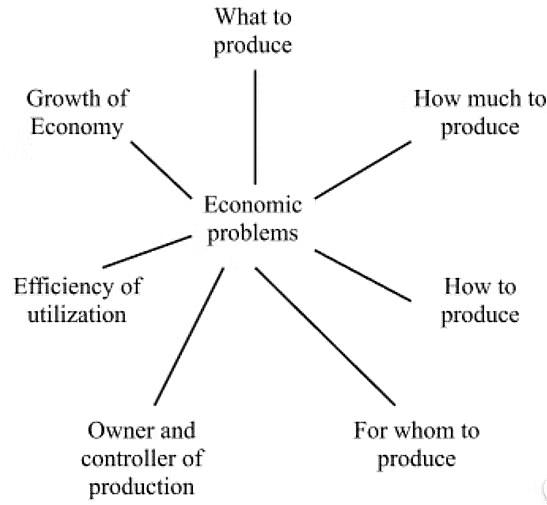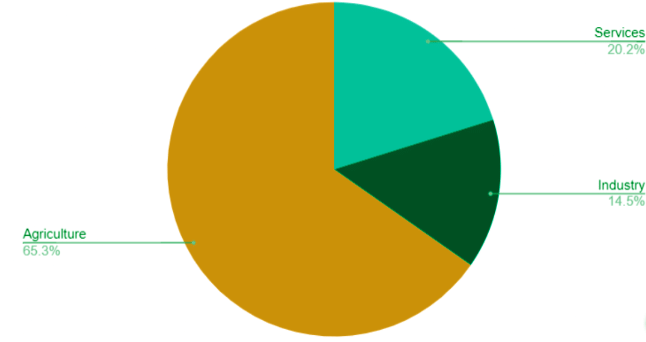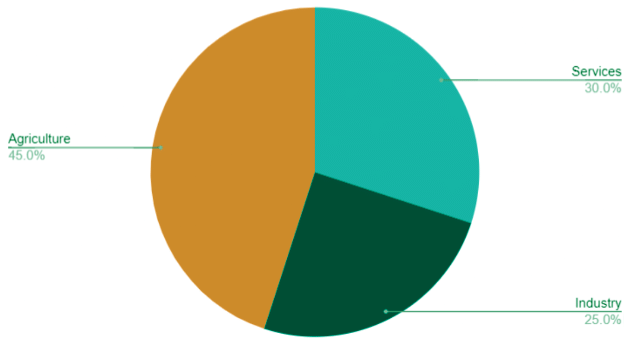Important Questions: Indian Economy 1950 - 1990 | Economics Class 12 - Commerce PDF Download
Very Short Answer Type Questions
Q1: What do you mean by the Planning Commission and who is the chairman of this commission?
Ans: The Planning Commission is an agency of the Indian government that was established in 1950 to oversee the country's economic and social development. Their primary responsibility is to create five-year plans. The chairman of the committee is the country's Prime Minister. This commission was abolished in 2014.
Q2: Who is the father of a high-yielding variety seed?
Ans: Norman Borlaug, an American agricultural scientist who was awarded the Nobel Peace Prize in 1970 for breeding higher-yielding varieties, is regarded as the father of HYV. He has also been dubbed the "Father of the Green Revolution."
Q3: What is meant by import substitution in Indian economy?
Ans: Import substitution industrialization (ISI) is a trade and economic policy that advocates substituting domestic production for foreign imports. ISI is based on the idea that a country should try to reduce its reliance on foreign goods by producing industrialized goods in its own country. Many mechanical, software, instruments, and machines are now being manufactured in our country in order to save crores of rupees in imports.
Q4: Define small scale industries.
Ans: Small scale industries are those with a fixed investment in plant and machinery, whether owned outright, leased, or hired out, that does not exceed Rs. 1 crore. Paper napkins, facial tissues, candle making kits, wooden toothpicks, and other items are examples.
Q5: Who presented the 1st five year plan of the country?
Ans: Pandit Jawaharlal Nehru, our country's first Prime Minister, presented the first five-year plan in parliament. It was first introduced in 1951.
Q6: Define Economy.
Ans: A large set of interconnected production and consumption activities that aid in determining how scarce resources are allocated is referred to as an economy. The economy is what allows us to survive and thrive.
Q7: What were the priorities in the 11th five-year plan?
Ans: Agriculture, infrastructure development, health, and education were the primary focus areas of the 11th five-year plan.
Q8: What do you mean by land ceiling?
Ans: The size of land that an individual or family can own is defined by the land ceiling. This act was passed in India in 1961-62 and was governed by all state governments. However, the ceiling limits differed from state to state.
Q9: What were the focus points of the first and second five year plan?
Ans: Agriculture was the primary focus of the first five-year plan, but in the second five-year plan, the emphasis shifted to industries.
Short Answer Type Questions
Q10: Why did India take up a mixed economy?
or
Amidst different types of economies in the world, why does India focus on a mixed economy model?
Ans: The country's leaders faced some difficult decisions in the post-independence era. Most countries in the world followed one of two models at the time: capitalist economy or socialist economy. Jawaharlal Nehru, our first Prime Minister, preferred the socialist model. A pure socialist economy, on the other hand, cannot thrive in a democracy like India. Capitalism was also unsuitable because the government needed to build an economy while also caring for the common man and his needs. As a result, our economy incorporated elements of both socialism and capitalism. It was then decided that India would build a strong socialist society in which the government would care for its citizens. The government, on the other hand, would promote and encourage a strong private sector in the future. With our democracy in mind, there would be no prohibition on private property or wealth. That is why the Indian economy is referred to as a mixed economy because it is neither completely socialist nor completely capitalist. In India, both the private and public sectors operate in the market. Despite the fact that privatization in most sectors did not begin until after 1991, it has provided a significant and much-needed boost to the economy.
Q11: What is meant by socialist economy? Elaborate with examples.
Ans: Socialism is primarily concerned with production in order to meet human needs. Unlike capitalism, where the emphasis is on sale and profit. Socialism entails workers exercising direct control and management of industries and social services through a democratic government based on their national economic organization. Karl Marx and Fredric Engles first introduced the concept of socialism in their book, 'The Communist Manifesto.' A socialist system is exemplified by the former Soviet Union. Denmark, Finland, Norway, and Ireland are all examples of socialist countries. Cuba is an excellent example. Its economy is run by the government, and there is no stock exchange. Healthcare and education are completely managed and administered by the government.
Q12: What was the aim of five year plans? Or Why did India need five year plans? Or What were the goals of five year plans in our country and how much has been achieved?
Ans: After gaining independence in 1947, India had to essentially rebuild its economy from the ground up. The leaders of the time will have to decide on the type of economy India would have as well as the economic planning. This is how the five-year plan came to be. These plans are known as five year plans in India because they are made for a period of five years. Each five-year plan is created with a specific goal in mind. A five-year plan has five generalized goals, of which one or two are given the most importance in a specific plan. So, the five types of goals that we cover in our five-year plans are shown below.
Main aims of five-year plans:
- Growth
- Modernization
- Self-reliance
- Equity
Some of the major accomplishments seen through five-year plans are listed below:
- Significant rise in national and per capita income.
- Good agricultural development
- Industrial development
- Transportation and communication development
- Job creation
- Power and price stability
- Scientific and technological advancements
- Increased capital formation
Q13: What is the policy of ‘land to the tiller’?
Or
Have you heard about land tiller policy? What is it?
Ans: The adage "land to the tillers" means that the person who works for something should reap the benefits and rewards. The Act, which has been previously restricted to owning property only for government projects, has been amended several times to broaden the definition of public purpose, so that land can now be acquired for any project and by anyone. The concept of “land to the tiller” is beneficial because it, above all, provides an incentive to the person who ploughs the land. It inspires the hardworking individual to work even harder.
Q14: What are the advantages and disadvantages of the green revolution?
Or
What are the drawbacks of the green revolution?
Ans: The green revolution refers to the significant increase in food grain production (such as rice and wheat) as a result of the introduction of high-yielding varieties, the use of pesticides, and improved management techniques. We will now look at the benefits and drawbacks of the green revolution.
Let us Begin With the Benefits of the Green Revolution:
- It enables large-scale agricultural operations.
- It eliminates the need to leave land fallow.
- It has the potential to grow any crop in any location.
- Job opportunities in the agricultural and industrial sectors are created.
The Following are Some of the Disadvantages of the Green Revolution:
- Constant crop replanting without restoring soil health necessitates the use of more fertilizer to keep nutrients in the soil and replenish them.
- It has a negative impact on crop production due to soil degradation, which results in decreased production of fruits, vegetables, and pulses.
- Small farmers were unable to keep up with the falling price of grains and production because they were unable to afford fertilizers, pesticides, machinery, HYV seeds, and other agricultural inputs, causing them to become poorer.
- Excessive use of chemical fertilizer, as reported in some areas, resulted in the destruction of beneficial microorganisms, insects, and worms in soil.
Long Answer Type Questions
Q15: What are the general problems of an economy?
Or
Throw some light on the central problems of the economy.
Ans: The below-designed module can help us understand the economy's problems. Green Revolution Components Reforms to the Land Marketing and rural roads Agricultural mechanization Command Area Development (CAD) for Rural Electrification.
 Now We Will Concentrate on Better Understanding the Problems:
Now We Will Concentrate on Better Understanding the Problems:
- The basic economic problem is one of scarcity of resources, which causes a problem of choice. It is also referred to as the resource economisation problem, which refers to the issue of making better and more efficient use of limited resources in order to satisfy the greatest number of wants.
- The main causes of central problems are unending human desires, limited economic resources, and alternative resource uses.
- One of the most important issues that every economy faces is resource allocation:
- What should be produced and how much should be produced?
- How do you produce?
- For whom should the product be produced?
- What to produce: An economy has unlimited wants but limited means that can be used in other ways. The economy cannot produce all types of goods such as consumer goods, producer goods, and so on. As a result, the economy must decide what types of goods and services to produce and in what quantities.
- How to Produce: This is a problem of selecting a manufacturing technique. There are two production methods.
- Labour-Intensive Technique: This is a production technique in which labor is used more than capital.
- Capital-Intensive Technique: Capital is used more than labor in this technique.
- For whom to produce: This is a problem related to the distribution of produced goods among various groups in society. It has two components: -
- Individual distribution
- Distribution of functionalities Personal distribution: When national income is distributed based on who owns the factors of production.
When the national income/production is distributed among different factors of production such as land, labor, capital, and entrepreneurship for providing their services in terms of rent, wages, interest, and profit, this is referred to as functional distribution.
- A problem Related to the Efficient Use and Full Utilization of Resources: Production efficiency means producing the greatest amount of goods and services possible with the available resources. Because resources are already scarce in comparison to the demand for them, an economy must ensure that its resources are not underutilized; underemployment is nothing more than resource waste.
- Resource Growth Problem: It is related to an increase in the economy's production capacity, which causes the quantity of production to increase.
Q16: Construct a pie chart on the occasional structure of the Indian economy available in the following table: Ans: For this, we will create different pie charts based on the year.
Ans: For this, we will create different pie charts based on the year.
Pie-chart for 1950-51
Pie-chart for 1990-91
Pie-chart for 2017-18
Q17: Explain the Green Revolution in brief.
Or
Why is the term Green Revolution so famous?
Ans: Food is the most basic requirement for all living creatures on this planet to survive. It is the source of energy used by living organisms for their growth, development, and work.
The Green Revolution was a scientific breakthrough in grain cultivation. It put genetic engineering, chemical fertilizers, and pesticides into use. It introduced fantastic farming technology. The Green Revolution in India refers to the period when agriculture in India transitioned to an industrial system as a result of the adoption of modern methods and technology such as high yielding variety (HYV) seeds, tractors, irrigation facilities, pesticides, fertilizers, and so on. Norman Borlaug pioneered the green revolution. India is self-sufficient in food production solely due to modern agricultural practices. The Green Revolution of the 1960s was a watershed moment in Indian history. The need for a new agricultural strategy arose as a result of the need to increase agricultural production in the face of production stagnation and rapidly rising demand. It was initially implemented over a total area of 1.89 million hectares. The coverage had grown to 9.2 million hectares on the eve of the Fourth Plan. In 1989-1990, the total area was 63.8 million hectares, accounting for nearly 35% of gross cropped area.
The Main Components of Green Revolution are as Follows:
- Better pesticides
- High yielding
- Better ignition
- Land reforms
- Command Area Development (CAD)
- Rural electrification
- Farm mechanization
- Rural roads and marketing
Agriculture production is slow, and investment is also insufficient. Even after the so-called success of the Green Revolution, India's production is far below that of the international structure. The actual yield of groundnut is 9.1 quintal per hectare, which is one-third of the world's highest yield rate. Thus, even after the Green Revolution, India's acre-wise productivity remains significantly lower than the international standard. However, India has surpassed the United States to become the fourth-largest wheat producer. The reality is that after the rural works programs and the course of actions, the middle and lower strata of rural society can benefit, if not the upper strata. The middle strata benefited greatly due to the size of their holdings. They became viable as a result of their entrepreneurial spirit. This emerging middle-income group gained more motivation to engage in additional economic activities. They imbibed zeal and confidence and could be a source of inspiration for others, emerging as a new leader in a society dominated by previously affluent classes. If the development process is democratic, this new leadership can take the necessary steps to usher in new developmental activities in rural society for the grass roots level. The new initiatives have the potential to spark a new wave of economic development in rural areas.
Q18: Though the public sector is very essential for industries, many public sector undertakings incur huge losses and are a drain on the economy’s resources. Discuss the usefulness of public sector undertakings in this light of the fact.
Or
Explain the rationale of public sector enterprises.
Ans: In India, a public sector company is one in which the Union Government, a State Government, or a Territorial Government owns 51 percent or more of the stock. Currently, only three sectors remain exclusively reserved for the government, namely railways, atomic energy, and explosive materials. Private companies are not permitted to operate in these sectors. Until the 1990s, major sectors of the economy were reserved solely for the government, resulting in a significant loss of our precious natural resources and trapping the entire country in a major economic problem. From the first five-year plan to the 1980s, our country grew at a rate of 3.5 percent per year on average.
Profitable public-sector enterprises are the government's primary source of revenue for special welfare programs. This enables the public to promote income and wealth distribution equality. PSUs with a social mission, such as railways, water supply, and postal services, should be kept in the public sector. Profitable industries should be kept in the public sector only because their resources can be used for development. The government should retain strategic industries in order to avoid the formation of monopolies in the private sector.
Role of Public Sector Enterprises in India
- Maximizing the rate of economic growth
- Balanced regional development
- Agricultural development
- Increased employment opportunities
- Import substitution
Governance of Public Sector Undertakings:
The following are the important roles and responsibilities of the Public Sector Department:
- General public policy.
- Issues pertaining to the issuance of Presidential Directives and guidelines to Public Sector Enterprises.
- Policy guidelines for Public Sector Companies in areas like performance improvement and evaluation, financial management, personnel management, board structures, wage settlement, training, industrial relations, vigilance, and performance appraisal, among others.
- Issues concerning the reservation of positions in public-sector enterprises for specific groups of citizens.
- All issues pertaining to the Memorandum of Understanding between Public Sector Enterprises and administrative Ministries/Departments.
- Issues pertaining to the delegation of powers to the Board of Directors.
- To conduct in-depth studies on key areas of Central PSE operation.
- Concerns about the International Centre for Public Enterprises (ICPE) - External website that opens in a new window.
- SCOPE (Standing Conference of Public Enterprises) - External website that opens in a new window
- Monitoring and evaluating the performance of PSEs, serving as a data repository, and producing an annual survey for the Parliament.
- Permanent Arbitration Mechanism for resolving disputes between public sector enterprises and Government Departments, excluding tax disputes
- Appraisal of proposals from various administrative Ministries pertaining to restructuring, revival, joint venture, and so on. Increasing the rate of economic growth as much as possible Regional development that is balanced Agriculture advancement expanded employment opportunities Substitution of imports
- DPE Guidelines - This is an external website that will open in a new window.
- Economic Affairs Department - External website that opens in a new window
- Expenditure Department - External website that opens in a new window
- Standing Conference Of Public Enterprises (SCOPE) - External website, which will open in a new window.
|
64 videos|308 docs|51 tests
|
















